The French Laundry
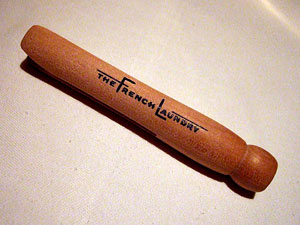 Dominic Armato |
|
I've been wanting to visit the French Laundry for a long, long time. Somewhere on the order of 8-9 years, I believe. But I remember exactly when it became a must. Alain Ducasse, arguably the world's most famed active French chef, did an interview for Le Monde. At this point, I'd had the opportunity to dine at Ducasse's Louis XV in both Paris and Monaco, and it was plainly evident to me that while he was an egotistical rabble rouser with a penchant for obscene decadence and the occasional bold failure (read: Spoon), when it came to traditional and slightly modernized French cuisine, the man knew what he was doing. And while it could certainly be argued that he was simply trying to get a rise out of French traditionalists, he made a rather controversial statement that made me want to book a flight and go straight to Napa. I don't remember the exact wording, but the essence was this:
"The best French cuisine in the world is no longer being made in France. It is being made in Napa Valley by Thomas Keller of the French Laundry."
Of course, this statement set off the kind of editorial free-for-all that is mystifying to those who are neither French nor culinarians. But the point was made. Something very, very special was going on in Yountville, California. When my sweetheart and I went to Napa last summer to scout locations for our wedding, it was all I could do to stay away. But owing to my sweetheart's restrictive work schedule, we had to do a one and a half day surgical strike. It was either skip the French Laundry or skip one of our three potential wedding destnations. So we resolved instead to make the French Laundry our first fine dining stop as a married couple. We were married this past Saturday, and are now off to a fantastically delicious start.
The French Laundry is, as its name suggests, housed in an old stone laundry building in Yountville, about ten minutes north of Napa. It's an unassuming little place from the outside... beautiful, but nothing that would grab your attention were you not searching for it. The first thing to bring an enormous smile to my lips was the fact that there was a beautifully tended vegetable garden just across the street. In reading up on Keller, I'd learned that while his dishes are often exceptionally creative modern twists on French cuisine, when it comes to sourcing ingredients, he's decidedly old-school. In fact, standing in sharp defiance of the current slow death of the art, he recently decided to open a butcher shop near his restaurant. But that will be another story for another trip. Walking the length of the building led us into a serene, walled courtyard with a view of the kitchen, partially obstructed by trimmed hedges. The kitchen was, unsurprisingly, impressive to watch. It was one of the kitchens you only see at this level... a flowing display of skill, precision, grace and economy of motion. There was none of the madness of most establishments, with shouted orders and flying pots and pans. It was Thomas Keller's art, reproduced again and again with calm efficiency in a pristine, white environment. The Man wasn't present, but his minions worked tirelessly in his absence. The restaurant itself was rather subdued... dark wood, blue upholstered chairs... as clean and minimal as classic French decor can be. The food, however, was on the opposite end of the spectrum.
There were three tasting menus to choose from... the vegetarian, the nine course, and the seven course. While the full nine course was exceedingly tempting, there were a few items on the seven course that grabbed us, so we decided to go in that direction. And everything, from start to finish, was absolutely spectacular. Much like Jean-Georges (my hero and thus far my gold standard for fine dining), he creates bold, simple dishes that are still monumentally creative. It isn't the Bobby Flay school of cooking, where you take every flavor under the sun and figure out how to pack it into a dish. Rather, through perfect ingredient sourcing and spotless execution, he creates dishes that are simultaneously minimal and powerful. Each and every dish blows you away, and upon finishing it you wish that you had just a few more bites... until the next dish arrives and blows you away yet again.
The dishes we tasted were, in order:
Gougères
Sadly, I don't have photos of the amuse bouche. I wasn't quite feeling brave enough to break out the camera. But when a woman at the next table started brazenly walking circles around her table, snapping everybody's plate with flash and laser autofocus, I started to feel significantly less concerned about subtly taking a quick snap with my tiny, silent ultracompact. At any rate, our first amuse was simple, traditional gougères. Oddly enough, I'd never actually had them before. But these were little bite-sized crisp pastries, filled with a creamy, warm, melted gruyère. A simple, tasty opener.
This is where the supreme domination of awesomeness began. Sadly, this is the worst photo of the bunch. I can assure you that it was far more appetizing in person. While I adore sea urchin, I understand why it's intimidating to a lot of people. That said, if everybody could have it like this, I suspect there would be a multitude of converts. The urchin roe itself was fantastic, with a delicate and smooth quality. It embodied the sweetness of the sea without being overly briny. And the black truffle pairing was both completely unexpected and spectacular. A few tiny bits of minced water chestnut added some welcome crunch, and every once in a while a bit of coarse salt gave it some punch. |
Well, Keller's use of quotes in his dish titles may be a little overdone, but his foie gras is not. Though it may appear burnt to a crisp in the photo, this was only on the outer edge. The inside was perfectly cooked, creamy and rich. Mustard and a fruit puree were, of course, fairly traditional, but I thought the use of the braised endive was very interesting. It was an unusually mellow foil for foie gras that I thought worked exceedingly well in concert with the other more aggressive flavors. |
Here, Keller almost wandered into Jean-Georges territory, and not in unwelcome fashion. What with the hamachi jr., bok choy and yuzu, this was clearly the Asian-influenced dish. While I don't see Keller unseating Jean-Georges as the master of this particular marriage anytime soon, this was, nonetheless, a spectacular dish. Two things made it for me. The yuzu-butter emulsion was wonderful, to be sure, but that's no stroke of genius. First, the consistency of the fish was absolutely divine. The presentation side was very heavily seared, resulting in a crispy crust that was as delicious as it was texturally pleasing, but the underside was still perfectly moist and flaky and everything else that you expect from an expertly prepared piece of fish. The second item that grabbed me was the mushroom. As our server explained, it had been poached in milk and then grilled. The result was a mild and delicious mushroom steak of sorts, the flavor of which had been beautifully coaxed out by the light grilling. It was an understated work of art on its own, and was a perfect complement to the fish. |
I am, admittedly, predisposed to enjoy any dish that utilizes bacon. But this really, truly was a wonderful use of our porcine friend. All of the other components, even when expertly assembled like this, wouldn't exactly seem inventive. And even in its complete form, it's no revolutionary dish. But taking a very traditional veal preparation and adding not just bacon but thick cut batons of excellent salty, smoky, porky bacon just elevated the dish to something special. It was not the most interesting dish of the night, but it may have been the most delicious. |
This dish, however, was both delicious and fascinating. This was the one that cemented Keller's place in my mind as one of the true greats, to sit alongside my idol. It would have been so, so easy for Keller to simply offer a traditional cheese course, perhaps with a fun marmelade or two, and nobody would have thought any less of him. But instead, he took a delicious cheese that was absolutely delicious enough to stand on its own, and built a work of art around it. The cheese was a cow's milk bleu, pungent, dense and creamy with very few veins. Then he provided both hot and cool counterpoints. The celery hearts were soft, moist and comforting, while the vinaigrette was... much to my surprise... spicy. It had been spiked with a healthy dose of ground chile pepper. And the only thing more surprising than the approach was that it worked so well. The celery tamed the cheese's pungency on the front end while the vinaigrette's faint burn enhanced it on the back end. Beautifully calculated and expertly executed. |
When you're dealing with an ingredient like the Meyer lemon, especially when it's in season, you don't have to do much to make it awesome other than condense the flavor. This sorbet was very straightforward, but carefully dressed, and it was a great follow-up to the cheese. |
I've always felt that a tendency to work with rhubarb is a good sign when getting to know a chef. There's something about the vegetal sweet and sour quality that lends rhubarb a captivating quality for those who care to look. This dish was a rhubarb bonanza, as it were. The crisp on top was rhuarb, the sorbet was rhubarb, the side walls of the torte were rhubarb, and the sauce was rhubarb. So with all of the sweet and sour going on, a little cream and spice was all it took to round out the dish. Awesome. |
Since they weren't the most visually stunning of the night, I've shown only one of the many treats that were brought out to complete the meal. My sweetheart received the vanilla creme brulée (pictured), while I was given a cinnamon panna cotta in a small ceramic pot. Of course, we switched midway through and both were delicious. We were also given a few wafer thin tuille cookies, toasted macadamia nuts that had been baked into some kind of chocolate pastry shell, and a small bag of shortbread to take home with us. |
For the past eight or so years, my mantra when it comes to fine dining has been this:
While we've had the opportunity to experience a multitude of wonderful restaurants, Jean-Georges in New York is operating on a plane of its own, head and shoulders above the rest.
In the end, I am beyond thrilled to report that Jean-George finally has some company in my mind. I think I still prefer Jean-Georges' dishes, but only as a matter of personal preference. With the heavier Asian influence and a penchant for purer, bolder flavors, Jean-Georges simply pushes all of my culinary buttons. But based on last night's meal, I could not for a moment say that he is a more capable, interesting or accomplished chef than Keller. In many ways, I think they're very similar. They both seem to have an obsession with detail that governs their creations. Keller would call it finesse, for which he has posted the dictionary definition in huge letters over the doorway of his kitchen. They both try to avoid palate fatigue by shocking your tastebuds with bold, simple flavors and then giving you just enough to leave them wanting. And they are both masters of consistency, turning out spectacular dish after spectacular dish without the slightest lull, lest they leave you with the impression that they might just be mortal.
They most certainly are not.

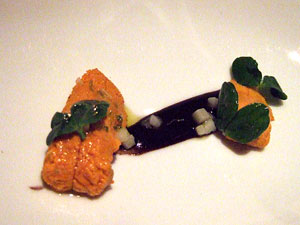
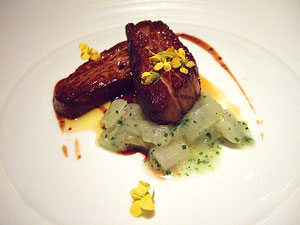
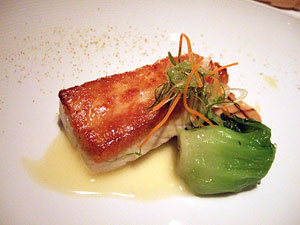
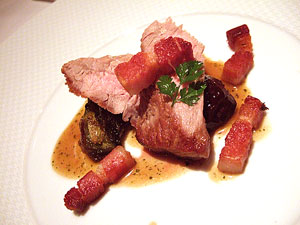
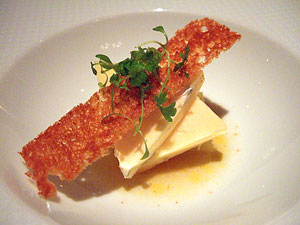
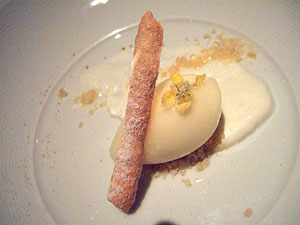

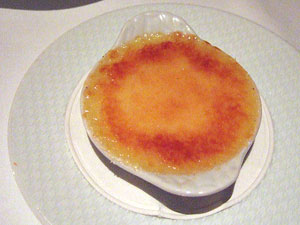

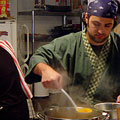
Comments